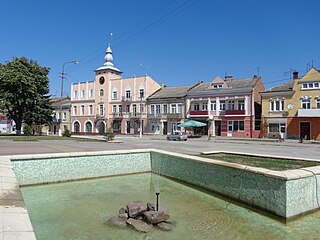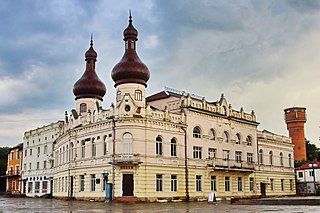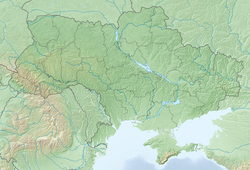
Okopy is a selo in western Ukraine. It is located in Chortkiv Raion (district) of Ternopil Oblast (province), and had its origins as a Polish fortress at the meeting of the Zbruch and Dniester rivers. It belongs to Melnytsia-Podilska settlement hromada, one of the hromadas of Ukraine.

Buchach is a city located on the Strypa River in Chortkiv Raion of Ternopil Oblast (province) of Western Ukraine. It hosts the administration of Buchach urban hromada, one of the hromadas of Ukraine. Buchach rests 135 kilometres south-east of Lviv, in the historic region of Halychyna (Galicia). The city was located in the Polish–Lithuanian Commonwealth until the partitions, followed by the Habsburg monarchy (1772–1804), Austrian Empire (1804–1867), Austria-Hungary (1867–1918), West Ukrainian People's Republic (1918–1919), the Second Polish Republic (1919–1939), and the Ukrainian SSR of the Soviet Union (1939–1991). The population was estimated at 12,171.

Budaniv is a village in Chortkiv Raion, Ternopil Oblast, in western Ukraine, near Terebovlya. It belongs to Bilobozhnytsia rural hromada, one of the hromadas of Ukraine. The population of Budaniv is 1,634 (2005). Before World War II, the village and its surroundings were part of the Second Polish Republic.

Husiatyn is a rural settlement in Chortkiv Raion, Ternopil Oblast, western Ukraine. It hosts the administration of Husiatyn settlement hromada, one of the hromadas of Ukraine. Husiatyn is located on the west bank of the Zbruch River, which once formed the old boundary between Austria-Hungary and the Russian Empire in the 19th century, and the boundary between Poland and the Soviet Union during the 1920s and 1930s. The population is 7,032.

Pidhaitsi is a small city in Ternopil Raion, Ternopil Oblast, western Ukraine. It is located approximately 15.5 miles (24.9 km) south of Berezhany, 43.5 miles (70.0 km) from Ternopil, and 62 miles (100 km) south-east of Lviv. In 1939, Pidhaitsi obtained the formal status of a city. It hosts the administration of Pidhaitsi urban hromada, one of the hromadas of Ukraine. Population: 2,609.

Borshchiv is a city in Chortkiv Raion, Ternopil Oblast, western Ukraine. It was previously the administrative center of the former Borshchiv Raion until 2020. Borshchiv hosts the administration of Borshchiv urban hromada, one of the hromadas of Ukraine. In 2022, the population was estimated to be 10,632.

Yazlovets is a village in Chortkiv Raion, Ternopil Oblast, Ukraine. It is a Roman Catholic pilgrimage centre of local significance. The village belongs to the Buchach urban hromada. It lies on the Vilchivchik river, a tributary of the Strypa and is located 16 km south of Buchach and presently has around 600 inhabitants. From 1947-91, it was known as Yablunivka. Apart from the ruined fortifications, there is little sign now that in the 15th and 16th centuries this was a thriving trading centre, on major international mercantile routes between the Black Sea and Northern Europe, and host to multiple merchant families of diverse ethnicities and religions. It was an instance of a privately owned settlement, such as was Zamość in Poland. The city's square has been entirely obliterated.

Skala-Podilska or Skala upon Zbruch is a rural settlement in Chortkiv Raion, Ternopil Oblast, Ukraine over the Zbruch River. It hosts the administration of Skala-Podilska settlement hromada, one of the hromadas of Ukraine. Population: 4,094.

Tovste is a rural settlement in Chortkiv Raion, Ternopil Oblast, western Ukraine. The town is located on the Ternopil—Chernivtsi automobile road in the historic region of Podolia, on the banks of the Tupa River, a tributary of the Seret. It hosts the administration of Tovste settlement hromada, one of the hromadas of Ukraine. Population: 3,156.

Saint Stanislaus Church is a Roman Catholic Church in Chortkiv of the Chortkiv urban hromada of the Chortkiv Raion of the Ternopil Oblast.

Krohulets is a village in Ukraine, Ternopil Oblast, Chortkiv Raion, Vasylkivtsi rural hromada.
Oleksyntsi is a village in Bilche-Zolote rural hromada, Chortkiv Raion, Ternopil Oblast, Ukraine.
Tudoriv is a village in Kopychyntsi urban hromada, Chortkiv Raion, Ternopil Oblast, Ukraine.
Mala Luka is a village in Hrymailiv settlement hromada, Chortkiv Raion, Ternopil Oblast, Ukraine.
Soroka is a village in Khorostkiv urban hromada, Chortkiv Raion, Ternopil Oblast, Ukraine.
Rozhanivka is a village in Tovste settlement hromada, Chortkiv Raion, Ternopil Oblast, Ukraine.
Solone is a village in Tovste settlement hromada, Chortkiv Raion, Ternopil Oblast, Ukraine.
Sokoliv is a village in Zolotyi Potik settlement hromada, Chortkiv Raion, Ternopil Oblast, Ukraine.
Vynohradne is a village in Zalishchyky urban hromada, Chortkiv Raion, Ternopil Oblast, Ukraine.
Bobulyntsi is a village in Buchach urban hromada, Chortkiv Raion, Ternopil Oblast, Ukraine.






























